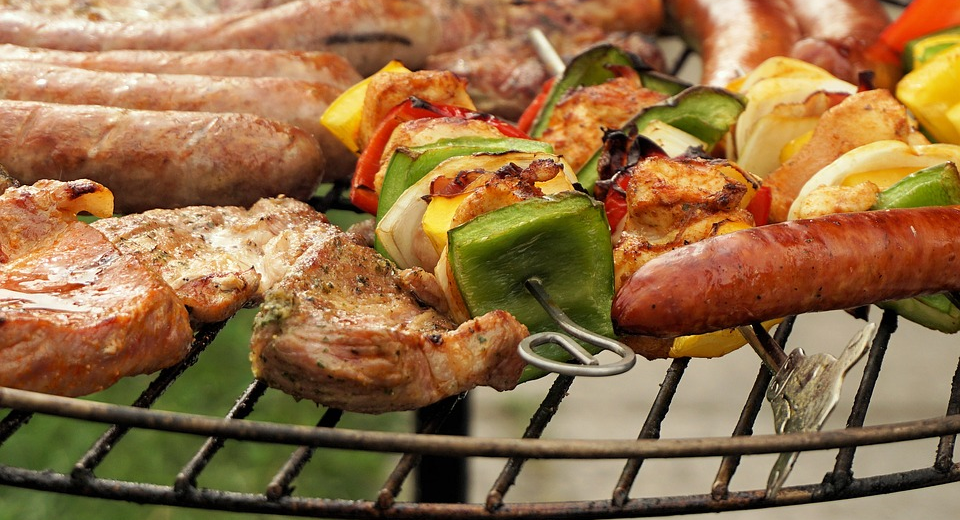What’s In Your Summer BBQ? Series (part 1 of 2)

It’s the best time of the year for outdoor get-togethers. What better way to relax, have fun, connect with friends and have something to eat? But how can you get the most out of BBQs without letting your health go up in flames? This article series will break down foods commonly chosen for BBQs and offer healthier alternatives. Learn how to make healthier choices for yourself and your kids this BBQ season so you can feel good about these outdoor get-togethers.
#1: The Meat
Hot Dogs
The bad news is that the classic grocery-store hot dog wieners served at most soccer team parties and end-of-year gatherings all over North America are nearly unfit for human ingestion. Ingredients in regular hot dogs include: “pink beef slime”, antibiotics, artificial flavour, MSG, sodium erythrobate, and sodium nitrite. If you think chicken hotdogs are better, they contain many of the same ingredients and include low-grade mechanically separated chicken parts. All beef hotdogs are not 100% beef either. These are made from what is called a “meat slurry” and can include pork bits and other animal parts. Hot dogs also have a very high concentration of sodium leading to dehydration, headaches, hypertension and other health problems for kids and adults.
Hamburgers
Hamburgers tend to be better for you than classic hotdogs, but still can hide some scarily unhealthy ingredients. Non-organic, non-grassfed beef can contain all sorts of antibiotics, hormones and steroids. If not a high-quality brand, they are also often made with “pink slime” . Fillers are used to bulk up hamburgers, and can be anything from wheat to starches and non-digestible fibers. Also, processed meats like hamburgers are notorious for having pathogens like E.coli and salmonella, and so are filled with ammonia to kill them off, while of course having negative effects on the human body as well. These negative effects include chronic gut and lung irritation, osteoporosis, and damage to the heart.
The good news is that there are alternatives to the classic processed factory BBQ meats. Higher-quality meat products are superior because they typically use real meat, and will often tell you if the animals were local and grass-fed or not. It is important to purchase grass-fed beef hamburgers because these are much less inflammatory and higher in nutrients than conventional corn- and grain-fed beef. Check that the ingredients don’t list preservatives like sodium EDTA, sodium nitrite, or erythrobate. Preservatives like these have effects like increasing asthma-related sensitivity, obesity, inflammatory bowel disease and blood sugar dysregulation. Check salt and additive levels by looking at the nutritional information label.
Hamburgers are naturally high in protein and saturated fat (and that is ok!) and unless they are packed with fillers, they should be low or completely lacking in carbohydrates and sugars. One source of decent patties is Kitchen Bytes: https://kitchenbyte.com/best-frozen-hamburger-patties/
Veggie Burgers
Of course another option is a veggie burger! These can sometimes be a wolf in sheep’s clothing, meaning that they pretend to be healthy when they’re not, unless you know what to avoid. To start, these can contain even more sodium than meat options, and the same number of preservatives. They can also be very low in protein, so it becomes more like a carbohydrate sandwich- carbs in carbs on carbs. If there is soy used in the burger, ensure it is organic because non-organic soy processing uses hexane, which is one of the most toxic substances found in food. For an excellent guide on veggie burger choices, see https://www.eatthis.com/veggie-burgers/.
Dr. Michael Mason-Wood makes an amazing mushroom burger that he freezes and then takes out for BBQ season.
#2: Meat charring
A very important final note about BBQs is about the carcinogenic effect of charring your meat. If you grill any meat at all at very high temperatures, it will naturally produce what are called heterocyclic amines (HCAs). HCAs are cancer-causing, period. A good rule of thumb is: if you are charring your food (ie getting that thick black crust developing from the flames), it is creating dangerous HCAs. This only applies to meats because they contain the building blocks of HCAs, whereas vegetables do not. In fact it’s important to note that grilling vegetables on an open flame is better than protecting them using aluminum foil, which can leach chemicals and metals into your food (especially if there is lemon. pineapple, or another acidic substance on your food).
Protect yourself when grilling meat by turning down the heat a touch, grilling your meats a little slower, and keeping them out of the direct flames. Always remember to scrape your grill clean in between grilling sessions to minimize leftover charring as well.
#3: The Bun
Now that we’re past the meat, the bun is the next most important ingredient. Of course buns are carbohydrates which turn to sugar in the body, but there are ways to make this a healthier carb choice than the classic white hamburger and hotdog buns. The first way is to go whole-wheat. This at least keeps some of the fibre in the bread so that it is broken down more slowly in the body, resulting in less of a bread-induced sugar high (and later, sugar crash). Include seeds and whole grains in buns to increase fibre and nutrient content even higher.
Another option is to go paleo for your BBQ and skip the bun altogether. Wrap your burger or hot dog in beautiful leafy lettuce, or eat it on top of other greens and salads. The protein and fat from the meat is what will help you feel satisfied and full for longer than you might think when you remove the bread.
Next week is the second part of this 2-part series on healthy summer barbecuing, with some of the best advice on how to really get the most out of your food and your whole summer!
References
- Pink Slime, Ingredients in Hot Dogs https://grist.org/article/2010-01-05-cheap-food-ammonia-burgers/
- Hamburger fillers http://www.fao.org/docrep/010/ai407e/AI407E16.htm
- Negative effects of ammonia https://www.atsdr.cdc.gov/phs/phs.asp?id=9&tid=2
- Health effects of preservatives https://www.nature.com/news/food-preservatives-linked-to-obesity-and-gut-disease-1.16984
- Meat charring and carcinogenic HCAS: https://www.mindbodygreen.com/0-13850/heres-how-to-avoid-carcinogens-when-youre-grilling.html
- Aluminum foil on the grill http://greenexaminingroom.com/the-health-risks-of-grilling-on-aluminum-foil/



